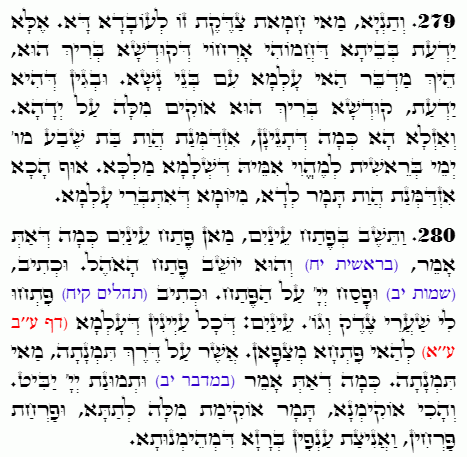Daily Zohar # 4671 – Acharei Mot – Looking towards the entrance
Daily Zohar 4671

Hebrew translation:
280. וַתֵּשֶׁב בְּפֶתַח עֵינַיִם. מִי זֶה פֶּתַח עֵינַיִם? כְּמוֹ שֶׁנֶּאֱמַר, וְהוּא יֹשֵׁב פֶּתַח הָאֹהֶל. וְכָתוּב (שמות יב) וּפָסַח ה’ עַל הַפֶּתַח. וְכָתוּב (תהלים קיח) פִּתְחוּ לִי שַׁעֲרֵי צֶדֶק וְגוֹ’. עֵינַיִם – שֶׁכָּל עֵינֵי הָעוֹלָם מְצַפִּים לַפֶּתַח הַזֶּה. אֲשֶׁר עַל דֶּרֶךְ תִּמְנָתָה, מַה זֶּה תִּמְנָתָה? כְּמוֹ שֶׁנֶּאֱמַר (במדבר יב) וּתְמוּנַת ה’ יַבִּיט. וְכָךְ בֵּאַרְנוּ, תָּמָר הֵקִימָה הַדָּבָר לְמַטָּה, וְהִפְרִיחָה פְרָחִים וְנִצְנְצָה עֲנָפִים בְּסוֹד הָאֱמוּנָה.
.
Zohar Acharei Mot
Continued from previous DZ
#279
We have learned: What did this righteous woman (Tamar) see that led her to this action? He answers: She knew, from her father-in-law’s house, the ways of the Holy One, blessed be He, and how He leads humanity in this world. And because she knew this, the Holy One, blessed be He, arranged the matter through her. This follows what we have learned: Batsheva was destined for David from the six days of Creation to be the mother of King Solomon. Similarly, Tamar was destined for Yehuda from the day the world was created.
Notes:
This passage illustrates how Tamar, through her awareness of divine providence, understood her destined role in the continuity of the House of David’s lineage. Just as Batsheva was ordained for King David, so was Tamar’s role in Hashem’s plan. The story emphasizes how Hashem leads the world, sometimes realized through the righteous actions of individuals who grasp their role in Hashem’s plan.
#280
“She sat at the entrance of eyes (עֵינַיִם)”
The Zohar asks: What is “Entrance of the Eyes? And it answers: It is as it is written, “וְהוּא יֹשֵׁב פֶּתַח הָאֹהֶל” “And he was sitting at the entrance of the tent” (Genesis 18:1), and it is written, “וּפָסַח ה’ עַל הַפֶּתַח” “YHVH passed over the entrance” (Exodus 12:23), and it is written, “פִּתְחוּ לִי שַׁעֲרֵי צֶדֶק” “Open for me the gates of righteousness” (Psalms 118:19). “עֵינַיִם” “eyes” refers to the fact that all the eyes of the world are waiting and looking towards that entrance, which is on the way to Timnah. What is “תִּמְנָתָה” “Timnatah”? It is like what is said, “וּתְמֻנַת יְהוָה יַבִּיט” “and the likeness of YHVH he shall behold” (Numbers 12:8). Thus, we have explained that Tamar established the matter in the lower world, and flowers blossomed, and branches sprouted, in the secret of faith.
Notes:
The Zohar uses “פֶתַח עֵינַיִם” “Petaḥ Einayim” “Entrance of the Eyes” as a metaphor for the gateway through which divine vision and spiritual revelation flow into the world. It connects various scriptural references to illustrate that Tamar’s actions were not only part of a physical narrative but also a spiritual event that led to the blossoming of faith and seeing the Light of Hashem. Through her, a more profound connection was established between the divine and the earthly, symbolizing the ongoing interplay between human actions and divine orchestration.
{||}

 Previous: Acharei Mot
Previous: Acharei Mot

